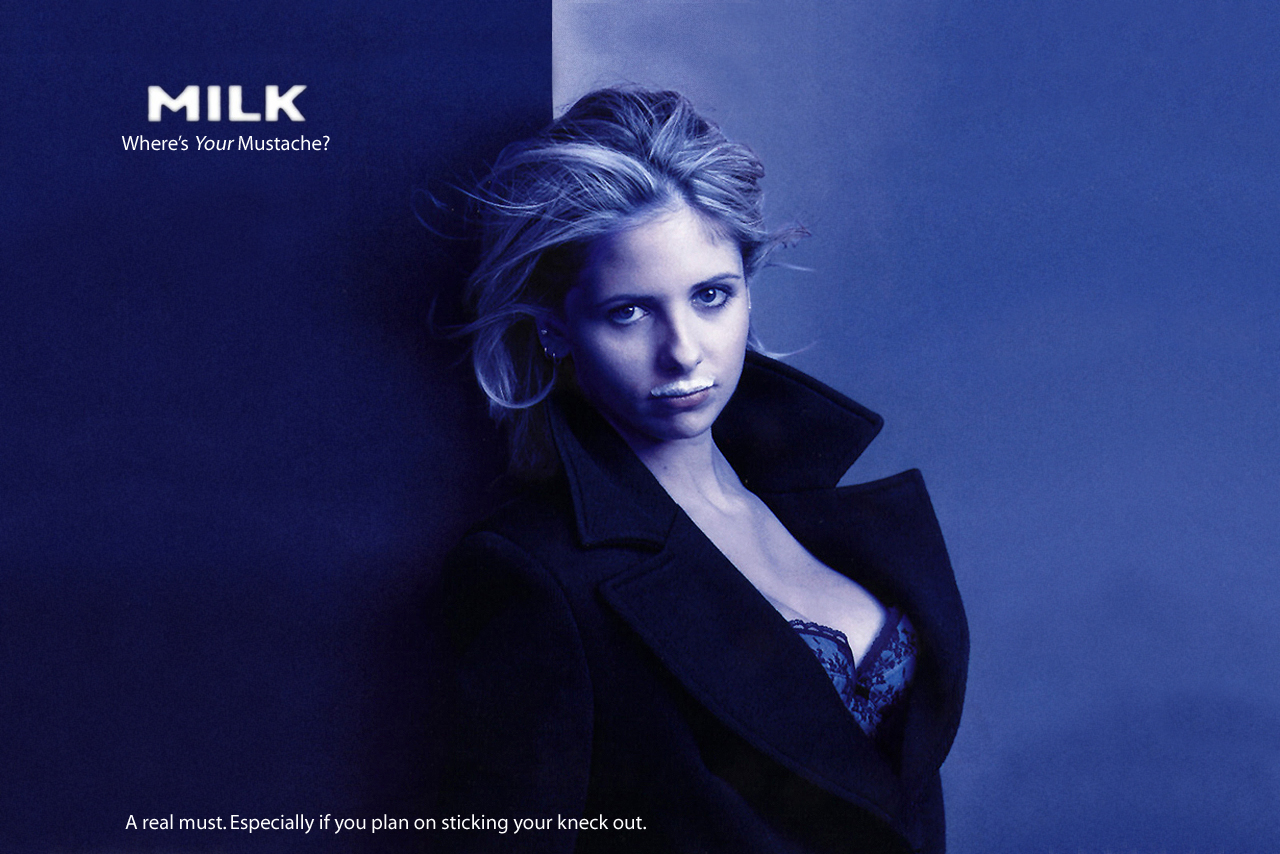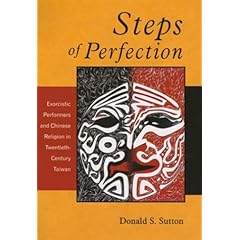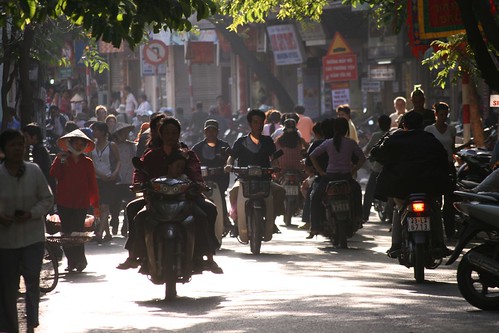Kung Fu Monks
Don't Get a Kick
Out of Fighting
Famous Temple Spurns
Beijing Games, Sparking
Trash Talk From Rivals
By GEOFFREY A. FOWLER and JULIET YE
December 14, 2007; Page A1
Kung fu master Shi Dechao can swing his 22-pound "monk's spade," an ancient Chinese shovel, like a majorette twirling a baton. His lightning punches, in a style the ancients called Iron Fist, generate a thunk! straight out of kung fu movie sound effects. A powerful grunt punctuates his routine.
But Dechao, and most of the other martial monks at the 1,500-year-old Shaolin Temple in China's central Henan province, decline to join in one of the biggest kung fu battles of modern times -- a competition to be staged in tandem with next year's Olympic Games in Beijing.
![[Shi Yongxin]](http://s.wsj.net/public/resources/images/HC-GL159_Shi_20071214001019.jpg)
Clad in saffron Buddhist robes, Dechao insists that real kung fu monks don't fight. They meditate and practice kung fu to reach enlightenment. "Every fist contains my love," says the 39-year-old Dechao, also known as Big Beard.
The Shaolin Temple's decision to stay out of the competition, to be held at the same time as the Olympics and passing out medals of its own, made headlines in China. And it has rekindled a disagreement familiar from the movies: Is kung fu a form of devotion, a style of fighting or both?
Zen Buddhism and kung fu have long made an unlikely pair. As legend has it, Zen's founder, an Indian missionary to China named Bodhidharma, worried that too much seated meditation would make monks flabby. So he taught the monks in Shaolin a set of 18 exercises codified as "Yi Jin Jing," or "Muscle Change Instruction," many of them based on animal movements.
|
WSJ's Geoffrey Fowler reports that the Chinese government wants to promote kung fu as a sport in the Olympics. But, the famous monks of the Shaolin Temple refuse to fight. |
"Kung fu is Zen practice in motion," says Shi Yongxin, the abbot of Shaolin, sitting in his office next to a sculpture of a meditating Buddha. When he moved to the temple from a devoutly Buddhist family in 1981, Yongxin learned to add kung fu moves to his meditation.
Over the centuries, the otherwise peaceful monks have occasionally used their physical prowess in battle to defend the temple and its allies. But they didn't always like it. In lore, the monks went to battle only when they were facing a life-or-death crisis and had no alternative.
Now, a debate over the Olympics has transported the classic kung fu monk's fight-or-pray dilemma to the 21st century.
For the Games, the Chinese have backed a committee-regulated version of kung fu split into two competitions. One, dubbed taolu, is a sort of rhythmic gymnastics in fast-forward. Individual athletes are scored on the "power, harmony, rhythm, style and musical accompaniment" of their routines, which have names such as Lotus Kick and Dragon's Dive to the Ground. A second form of kung fu competition, called sanshou, involves fighting -- and a fair amount of protective padding. Kung fu itself is also known as wushu.
![[Wushu]](http://s.wsj.net/public/resources/images/AH-AC401_WUSHU_20071213150603.jpg) |
Justin Guariglia |
Today, kung fu is practiced by more than 60 million Chinese and millions more around the world. |
At the International Wushu Federation's Ninth World Wushu Championships in Beijing last month, fighter Zhang Yong entered the ring to chants of "Go for it, China!" He won the gold medal in the 65-kilogram (143-pound) combat competition by striking his Russian opponent with a fierce combination of kicks and punches, at one point flipping the Russian into the air.
"Sometimes I get hurt during the training," says the 24-year-old Mr. Zhang, a Muslim, pointing to a scab on his right eyebrow. Yet "wushu is something that starts with fighting and ends with spirit," he says. "This spirit isn't a religious concept, but rather love to the nation."
To the monk Dechao, the spirit, or qi, in Shaolin Buddhism is embodied in breathing, not force. "I can practice kung fu internally while drinking tea quietly with my friends," he says.
After the abbot publicly distanced Shaolin from the Olympics in October, Chinese bloggers and athletes began to suggest the monks are just scared they wouldn't win. At the competition, athletes said their sport was simply not comparable to Shaolin meditation.
"We are the best wushu competitors," says Ma Lingjuan, the 21-year-old Chinese world champion in taolu. She has been practicing spinning and jabbing a spear since she was 10. "Our goal is the medal," she says. "The monks in the temple do it as a hobby."
Yongxin, the abbot, says monks practice kung fu "with an understanding of Zen Buddhism and love of the temple. On the other hand, the athletes use wushu as a way to find honor. It is easy to tell which one is more sustainable and deep."
Whether with blows or rhetoric, it seems, everybody is kung fu fighting.
Controlling Kung Fu
The government's efforts to standardize the diverse practice of kung fu were also designed to control it. After China's 1949 revolution, the Communist Party at first promoted martial arts but eventually grew leery of kung fu as a subversive self-defense practice.
![[Kung Fu]](http://s.wsj.net/public/resources/images/P1-AJ878_WUSHUJ_20071213201511.jpg) |
Fighters at Wushu championship in Beijing in November, and monk Shi Dechao (inset) |
During the Cultural Revolution of the '60s and '70s, the Red Guards attacked the Shaolin Temple and other religious orders. By the early 1980s, after centuries of unbroken master-to-student lineage, only a dozen or so monks lived at Shaolin. Outside the temple, though, traditional kung fu schools, not all of them associated with Buddhism, thrived.
'Chopsocky' TV
In the 1970s and 1980s, a blizzard of "chopsocky" TV shows and films, such as the 1982 Jet Li film "Shaolin Temple," helped to sear the Buddhist legends into the popular imagination, both in China and abroad.
The 1970s American TV show "Kung Fu" featured David Carradine as Kwai Chang Caine, a Shaolin monk who travels through the Old West armed only with his kung fu. In flashback scenes to the temple, his master teaches him to "avoid rather than check. Check rather than hurt. Hurt rather than maim. Maim rather than kill."
Today, kung fu is practiced by more than 60 million Chinese and millions more around the world -- and its purpose remains a topic of debate.
"The Shaolin Temple is only a building," says Kang Gewu, the secretary general of the Chinese Wushu Association. He points out that martial arts had existed in China for centuries before the Shaolin temple began practicing kung fu. He adds: "In our mind, wushu is a sport, not a religious practice."
It can be both. The town around Shaolin is home to dozens of wushu schools, some employing monks from the temple who accept as students both the spiritually and competitively inclined.
Meeting Place of Paradox
"Shaolin is a meeting place of paradox -- tourism, Zen, military, sports, communism, martial arts, history," says Gene Ching, the associate publisher of Kung Fu Tai Chi magazine in California. He thinks the debate between the monks and the athletes over spiritual affairs is "fairly artificial."
![[Zhang Yong]](http://s.wsj.net/public/resources/images/HC-GL158_Zhang_20071214001023.jpg)
For the temple, maintaining its image as the capital of kung fu is about both expanding its reach and paying its bills. Yongxin, who has been dubbed the "CEO abbot" in the press, has installed a spectacle of his own: a one-hour stage show featuring music by "Crouching Tiger, Hidden Dragon" composer Tan Dun and the kung fu skills of hundreds of back-flipping students. Tickets cost $32.
Even as he distances himself from Olympic competition, "the abbot keeps this stereotype alive that kung fu is about fighting," says Justin Guariglia, a photographer who spent several years getting to know the monks and recently published a book, "Shaolin: Temple of Zen." The "real monks," he notes, are kept far away from the tourists.
The abbot, periodically checking his cellphone during an interview, said the temple doesn't actually make that much money from the tourist activities. "What we have done is spread Buddhism and its spirit of universal love," he said.
Another monk at Shaolin, named Bodhidharma after the Indian missionary, dismisses suggestions that the monks don't want to play because they are afraid they would lose.
"Oh, lord," laughs Bodhidharma, who lives in Malaysia and visits the temple to meditate from time to time. "Monks have a very kind and patient heart. We could win that. But we don't want to hurt anybody."
--Sue Feng contributed to this article.
Write to Geoffrey A. Fowler at geoffrey.fowler@wsj.com and Juliet Ye at juliet.ye@wsj.com
| 

 Last month I was at a family gathering and there was a five month old girl who was crying. Her aunt, who has several wild children of her own, tried rocking her and then bouncing her, but the baby was still crying. Then with a big grin she announced, "We are going to have to try Monkey Swings." I can now verify from my observations that monkey swings are an effective crying control mechanism.
Last month I was at a family gathering and there was a five month old girl who was crying. Her aunt, who has several wild children of her own, tried rocking her and then bouncing her, but the baby was still crying. Then with a big grin she announced, "We are going to have to try Monkey Swings." I can now verify from my observations that monkey swings are an effective crying control mechanism.
 As you are imaging this, you might think that the baby's head would flop backwards like that of the child on the swing above. But it didn't. The baby's head stayed right in line with its torso. This was a five month old I was watching, a younger baby probably would have had a floppy head. An older child would certainly be able to do this, but in most cases it would be obvious that they were using voluntary neck muscles.
As you are imaging this, you might think that the baby's head would flop backwards like that of the child on the swing above. But it didn't. The baby's head stayed right in line with its torso. This was a five month old I was watching, a younger baby probably would have had a floppy head. An older child would certainly be able to do this, but in most cases it would be obvious that they were using voluntary neck muscles. Southern Shaolin, like Choy Li Fut, seems like it was formed by people familiar with fighting in confined spaced, narrow corridors, and tight corners.
Southern Shaolin, like Choy Li Fut, seems like it was formed by people familiar with fighting in confined spaced, narrow corridors, and tight corners. Years ago I had the opportunity to meet
Years ago I had the opportunity to meet 


 I just wanted to throw this term out into cyberspace and see if anyone is interested in discussing what it means.
I just wanted to throw this term out into cyberspace and see if anyone is interested in discussing what it means. Before our former vice president invented the internet I had a habit of reading thick scholarly books. Now, I have to go hide out in the mountains for a few days or feign illness if I want to get through something really erudite.
Before our former vice president invented the internet I had a habit of reading thick scholarly books. Now, I have to go hide out in the mountains for a few days or feign illness if I want to get through something really erudite. Then there is the corner of medicine and elite scholarly exchange which merges in to the much larger realm of commerce.
Then there is the corner of medicine and elite scholarly exchange which merges in to the much larger realm of commerce.![[Shi Yongxin]](http://s.wsj.net/public/resources/images/HC-GL159_Shi_20071214001019.jpg)
![[Wushu]](http://s.wsj.net/public/resources/images/AH-AC401_WUSHU_20071213150603.jpg)
![[Kung Fu]](http://s.wsj.net/public/resources/images/P1-AJ878_WUSHUJ_20071213201511.jpg)
![[Zhang Yong]](http://s.wsj.net/public/resources/images/HC-GL158_Zhang_20071214001023.jpg)
 I want to announce that we have officially entered the Era of Conditioning.
I want to announce that we have officially entered the Era of Conditioning. I'm anti-conditioning. I believe in doing things form the inside out. If I said, "I believe in beginning from the heart," you could accuse me of being a silly romantic. But it's not because I want to bring out genius, or preserve mystery, I just prefer spontaneous unconditioned responses.
I'm anti-conditioning. I believe in doing things form the inside out. If I said, "I believe in beginning from the heart," you could accuse me of being a silly romantic. But it's not because I want to bring out genius, or preserve mystery, I just prefer spontaneous unconditioned responses.
 As Americans we have always come face to face with cultures different from our own. Multi-culturalism is an ethic based on our sense of what is right and good and desirable in a society. Unfortunately multiculturalism often gets conflated with cultural relativism.
As Americans we have always come face to face with cultures different from our own. Multi-culturalism is an ethic based on our sense of what is right and good and desirable in a society. Unfortunately multiculturalism often gets conflated with cultural relativism. If you are teaching "qigong healing" and just happen to pull a rabbit out of your hat, is it ethical to say "My qi is feeling jumpy today?" I think not. I think you should say, "I will now attempt to pull a rabbit out of my hat," do the deed, then say, "Ta-Dah!" and take a bow.
If you are teaching "qigong healing" and just happen to pull a rabbit out of your hat, is it ethical to say "My qi is feeling jumpy today?" I think not. I think you should say, "I will now attempt to pull a rabbit out of my hat," do the deed, then say, "Ta-Dah!" and take a bow.